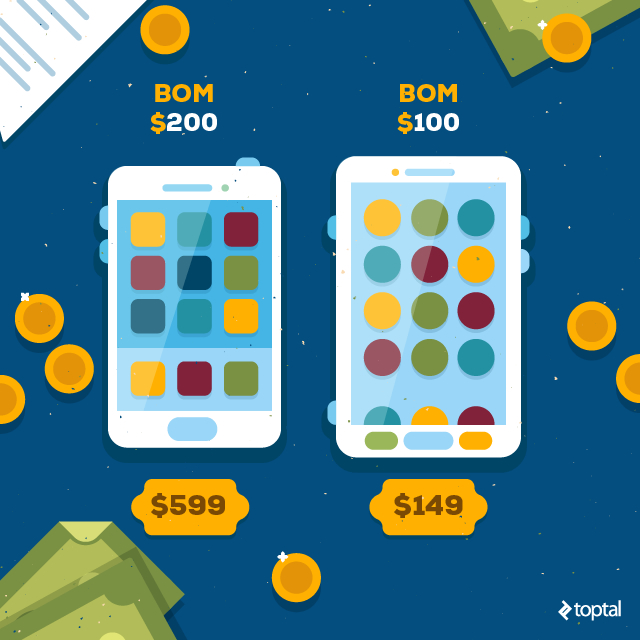Commoditized Smartphones: Bringing 4G To Developing Countries
Are we really going to need $500 phones to get people in developing countries on 3G or 4G? Not really.
Welcome to the world of commoditised smartphones. Allow us to explain what’s going on and why it could have a significant impact on software and hardware industries.
Are we really going to need $500 phones to get people in developing countries on 3G or 4G? Not really.
Welcome to the world of commoditised smartphones. Allow us to explain what’s going on and why it could have a significant impact on software and hardware industries.

Nermin Hajdarbegovic
As a veteran tech writer, Nermin helped create online publications covering everything from the semiconductor industry to cryptocurrency.
Expertise
Your 2012-vintage phone is dead. You’re not committed to a specific carrier through a two-year contract, you don’t care about brand loyalty, and you’re not one of those people willing to spend heaps of money on leading-edge gadgets. You head online to look for a replacement, thinking you are about to put a dent in your monthly budget, but you soon realise that you can get a perfectly good smartphone for the price of lunch for four.
What happened? A good phone used to cost as much as a mid-range laptop, but now you’re looking at dozens of $150 to $250 Androids that make your old phone look like an abacus strapped to a car battery.
Welcome to the world of commoditized smartphones. Allow me to explain what’s going on and why it could have a significant impact on software and hardware industries.
Smartphone Economics 101
If you’re a loyal iPhone user, or an Android power user, there is a good chance you’re unaware of the price war brewing in the rest of the market. If you use a flagship phone, you probably never take a look at entry-level and mainstream devices, and that’s understandable. The cost of getting a premium phone, like an iPhone or any of a number of Android devices, hasn’t changed in years.
However, brutal competition in other market segments has brought about a near-disastrous price slide. More than a billion smartphones were shipped last year, by countless brands. With dozens of vendors vying for the same slice of the pie, retail prices were slashed to a minimum, and so were the margins. The margin cut had a significant impact on some vendors (and it might force some to pull out of the business entirely).
Who cares, lower margins mean better value for the consumer? Right?
Yes they do, but they also compel phone makers to shift more devices to turn a profit, or simply break even. This is proving problematic in a mature market because smartphone penetration is already high in most developed countries. However, the process of Android commodification could help get the rest of the planet hooked on high-speed mobile broadband.
When people look at the smartphone market, they usually look at the hardware under the bonnet, the operating system, and the market share or shipment volume for different brands and platforms. The numbers usually tell us a lot: Which platform is gaining popularity; what sort of hardware is hitting the market; how long old devices with outdated operating systems and hardware can keep going, and so on.
However, these metrics aren’t enough to paint the full picture, so in order to illustrate what makes inexpensive phones different, we need to take a look at a few more.
- Bill Of Materials (BOM)
- Average Selling Price (ASP)
- Margin
From a technological perspective, the difference between an iPhone 5C and iPhone 6S isn’t that big, and neither is the difference between a flagship Android phone from Samsung and a commoditized “white box” smartphone. However, if you take a look at them through the eyes of an accountant rather than a geek, the difference becomes huge.
Let’s say Apple and Samsung introduce a couple of new flagship phones. Their BOM will be close to the $200 mark (many people are surprised to learn that some Android flagships cost more to build than iPhones). The ASP is going to be in the $400 to $700 range, but deducting the BOM from the ASP is not enough to figure out the margin. The BOM does not include the cost of marketing, R&D, intellectual property and so on. In other words, you can sell $200 worth of hardware for $600 and still make less money than a competitor selling $250 of hardware for $500. Apple usually has the best margins in the business, and the Android gang can’t come close.

What makes commoditized devices so different? It’s not the hardware or software, it’s the economics.
These devices are designed and built to a budget, so instead of getting $200 worth of hardware for $500, the consumer gets $120 of hardware for $150 or less. This might not be a huge deal in developed markets, but let’s not forget about the remaining six billion people on this planet we call home.
To them, this price gap is staggering, and that’s what matters.
Commoditized Android Smartphones Don’t Have To Suck
At this point you’re probably thinking that these cheap phones can’t come close to your iPhone or Galaxy in terms of performance, and you’re right. However, they don’t have to. In terms of pricing, they’re not nearly in the same league, but they tend to offer better value for money. Basically, consumers can decide to pay a quarter of the price of a flagship Android device, but they’ll miss out on about 10 percent of features reserved for high-end devices. Sounds like a good deal, and, speaking from personal experience, it usually is a good deal.
I tried out a lot of hardware over the years, both as a professional reviewer and hobbyist, and in recent months I had a chance to try out a number of these budget devices. The latest one was an aluminium smartphone, with 4G/LTE connectivity, a 5.5-inch 1080p display, octa-core processor, 2GB of RAM, 16GB of storage, fingerprint scanner, fairly good 13-megapixel camera and a huge 4000mAh battery. The real kicker was the price: $179. Mind you, this is not a nameless, white box smartphone; it comes from Xiaomi, the biggest smartphone vendor in China. The phone looks and feels good, and ships with one of the best looking Android forks in the business (MIUI).
It’s a cheap phone, but could I live with it? Definitely. Of course, it’s not as good as a new iPhone 6S or Nexus P6, but given the price, it doesn’t have to be. It’s good enough, and then some.
When I bought my first iPhone in 2009, I really didn’t have much choice. At the time, Android was still a mess and Android phones failed to impress me. Unfortunately, I forgot about certain annoying aspects of iTunes and Apple policies in general, which compelled me to sell my iPod a few years earlier. So, I ditched the iPhone as soon as I found an adequate Android replacement. I know Apple has revamped iTunes a few times since, but I am not planning to go back. This has nothing to do with the quality of Apple software or hardware, which is great. It’s a subjective thing, a matter of principle: I just don’t like to buy hardware that tries to lock me into proprietary standards and services; whether it’s from Apple, Sony, Whirlpool, or someone else, I tend to stay away.
So, what’s Apple got to do with it? Or Whirlpool, for that matter?
I spent the better part of a decade working for various tech news sites, but I could never get the smartphone hype, and here is why: In virtually all other industries, mainstream products are the bread and butter, but in the smartphone business, it’s all about flagship products. Everything is upside down. Think about it, how many people go out and buy the best and biggest Sony TV out there? Or the most expensive and powerful MacBook or ThinkPad? Most people don’t, yet these same people buy expensive flagship phones. I view it as a market anomaly, something to be expected in emerging, high-growth industries, but not in mature markets. This anomaly was made possible by carriers, who subsidised smartphone sales, or offered easy 24-month payment schemes bundled with their voice and data plans. Without them, fewer people would choose to spend $700 to $1,000 on a phone every year or two, especially if they could get a perfectly good phone for a quarter of the price.

The problem for smartphone makers is that their products are maturing, and they’re finding it increasingly difficult to market them to their traditional audience. While overall smartphone sales are still going up, the sales figures also show some worrying trends. Analysts recently revised their iPhone shipment forecasts for this year, slashing a few million units from their targets. Samsung went through a few rough quarters. Industry veteran HTC lost much of its market share, and even high-growth Chinese outfits like Xiaomi are being forced to revise their forecasts downwards.
That’s the problem with mature products; you don’t buy a new microwave every two years, and if you buy a new phone today, chances are you won’t really need to upgrade it for two to four years. Coupled with relatively low ASPs and brutal competition, these trends are conspiring to make 4G devices accessible to hundreds of millions of people around the world, people who can’t, or don’t want to, buy an expensive flagship phone.
Good News For Consumers And Developers?
Let’s let the captains of industry and their shareholders worry about margins, shipments and profits. What I want to know is what all this means for the average consumer, and mobile app developers and designers?
Are we really going to need $500 phones to get people in developing countries on 3G or 4G? Not really. The per-capita median income in developed countries tends to be relatively high, ranging from about $7,000 to $14,000 in most EU member states. North America averages about $15,000, while developed economies in Asia, such as South Korea and Japan, end up in the $10,000 to $12,000 range.
Russia’s reported income is $4,129, and there are some even lower figures in Central and Eastern Europe. In China, the average median per-capita income is $1,786, according to Gallup data. In India, it’s just $616, and it’s even lower in some parts of Asia such as Indonesia, Bangladesh and Pakistan. Malaysia is better off, with a median income of $2,267. Brazil’s is close, at $2,247 per capita, and most of South America is in the $1,000 to $3,000 region. Nigeria’s median per-capita income is just $493, and the situation isn’t much better in the rest of Africa.
These countries don’t have much in common, but almost all of them have populations of over 100 million, and most people in developing countries cannot afford expensive products and services. All these countries already have 4G networks, either in full-scale operation, or as pilots.
Big brands usually don’t even bother with this particular market segment, despite its obvious potential. They prefer to focus on high-margin brackets instead.
This is where it gets interesting: 4G phones used to be expensive for a reason, but the ability to use high-speed TDD and FDD networks is no longer a market differentiator since even cheap phones can do it. As mobile carriers continue pushing new network standards, prices will go down and fast 4G data will be within reach of hundreds of millions of people who can’t afford it today. In fact, in some markets, like China, we’ve already seen consumers leaping from 2G to 4G connectivity in a single product generation. The difference between 3G and 4G speeds is big, but 3G is still fast enough for most people. However, the difference between 2G and 4G is staggering.

A smartphone stuck on 2G is not much of a “smart” phone because its functionality is limited (until it’s hooked up to WiFi). On 3G, you can do almost anything, and 4G is faster than most landline ISPs, at least in theory. Bottom line: People in many developing countries didn’t have much of a chance to use smartphones the way they’re supposed to be used. The devices were too expensive, mobile data was relatively slow and too expensive. This is changing. Fast.
By the end of the decade, these users, who are currently having trouble getting decent 3G coverage in their town, will probably be using much faster, and more reliable, 4G networks. They will start using their smartphones and other connected devices in much the same way their counterparts in developed countries.
Sounds good. We will add a few hundred million smartphone users by the end of the decade, with good hardware and data connectivity.
That sounds like a huge, untapped market, but there is a caveat.
Not All Users Are Created Equal
Remember when Facebook was expanding like mad? Every couple of quarters we would hear about a new milestone: 300 million users, half a billion, 700 million, and so on. This was a couple of years before the controversial Facebook IPO, so the impressive numbers attracted a lot of scrutiny. Analysts quickly realised that the growth in the number of users would not correspond with revenue growth in the long haul.
The reason? Once Facebook managed to attract more than half a billion users, it had saturated developed markets. After 700 to 800 million users, most growth was coming from developing countries, and that’s still the case. More users usually means more revenue, but how much? It depends on the geographic location and disposable income of the user. If a service relies on ads for monetisation, a million users in Europe and the US will generate more revenue than a million users in China or India. This also applies to premium, or freemium, business models as fewer users in developing countries will be willing and able to pay for your service and will use free alternatives instead.
Bear in mind that you still need the same infrastructure to cater to all users, so you still pay for development, server real-estate, and support, regardless of where your users are located. A single user will cost you the same no matter what, but different kinds of users are bound to generate vastly different revenues.
In other words, it may be necessary to rethink monetization strategies moving forward, and that should be the takeaway for Android developers and publishers.
As far as the technical aspect is concerned, it’s mostly good news for designers and developers. They won’t have to tweak their products to suit watered down devices built to a budget. On the contrary, even $100 to $200 phones tend to pack good hardware nowadays (modern 64-bit ARMv8 processors, plenty of RAM and storage, high definition 1080p displays and so on). If an app or web service looks and works well on a flagship phone, it will probably look just as good on a cheap one, and that’s the beauty of it.
The only problem I can think of is the limited sensor suite found on most such devices. This is where vendors can cut corners without degrading the user experience. For example, if your app relies on gyro and e-compass input, it won’t work properly on some of these devices. Actually, this sounds like a simple issue we could address in our common Android mistakes section.
Hardware will not be a problem, but that does not change the fact that we will have to be more creative when it comes to monetization. The biggest upside? Inexpensive phones and higher 4G penetration will allow hundreds of millions of people to finally make the most of their money and take full advantage of the latest services and technologies.
